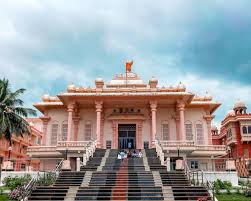GS1 – Modern History

Context:
Maharashtra’s first temple dedicated to Chhatrapati Shivaji Maharaj was officially inaugurated in Bhiwandi.
Significance and Architectural Highlights
- This temple is the first of its kind in Maharashtra and the second in India, with the first being in Srisailam, Telangana.
- Main Statue: A 6.5-foot idol of Chhatrapati Shivaji Maharaj, sculpted by renowned artist Arun Yogiraj.
- Construction & Materials: The foundation stone was laid in 2017. Built by Shivkranti Pratishthan, it incorporates reinforced concrete, bricks, and real stone for longevity.
- Architectural Influence: Inspired by Shivaji’s forts, the structure features fortified walls, bastions, and a grand entrance.
- Design Elements: The temple’s main hall (sabha mandap) stands 42 feet high, with a teakwood entrance gate. It includes circular bastions, artistically carved pillars, five spires, and decorative temple arches (mahirap).
- Murals & Museum: Showcases 36 murals (each 9×6 feet) depicting Shivaji’s life, along with a museum displaying historical weapons and a landscaped garden.
Chhatrapati Shivaji Maharaj – A Historical Icon
Early Life & Military Campaigns
- Birth: February 19, 1630, at Shivneri Fort, Maharashtra, to Shahaji Bhonsle and Jijabai.
- First Conquest: Seized Torna Fort in 1645 at just 15 years old, marking the beginning of his military expansion.
Warfare & Resistance Against the Mughals
- Guerrilla Warfare Tactics: Expertly used hit-and-run attacks, ambush strategies, and fortified defenses to counter the powerful Mughal army.
- Conflict with the Mughals:
- Signed the Treaty of Purandar (1665), surrendering 23 forts to the Mughals.
- Successfully reclaimed Purandar Fort in 1670.
- Escaped from Aurangzeb’s captivity in Agra (1666) using strategic deception.
Administration & Governance
- Coronation: Declared Chhatrapati on June 6, 1674, at Raigad Fort, officially founding the Maratha Empire.
- Efficient Governance: Established the Ashta Pradhan (Council of Eight Ministers) to streamline administration and introduced a robust revenue system.
- Naval Strength: Developed a formidable naval force, safeguarding coastal regions, earning him the title “Father of the Indian Navy.”
- Diplomatic Strategies: Engaged in strategic treaties, including those of Purandar and Rajapur, to navigate conflicts and forge alliances.
- Religious Harmony: Advocated for secular governance, ensuring equitable treatment of all communities.
Legacy & Enduring Influence
- Demise: Passed away on April 3, 1680, leaving behind a strong and resilient Maratha Empire that shaped Indian history.
Efforts to Honor His Legacy
- UNESCO Heritage Status: The Maharashtra government has proposed UNESCO recognition for 12 Maratha forts under the Maratha Military Landscape of India, including:
- Lohagad, Salher, Raigad, Rajgad, Pratapgad, Shivneri, Suvarnadurg, Vijaydurg, Sindhudurg, Panhala, Khanderi (Maharashtra), and Gingee (Tamil Nadu).
- Planned Agra Memorial: The state has also sought approval for a memorial in Agra, commemorating Shivaji Maharaj’s daring escape from Aurangzeb’s captivity in 1666.




